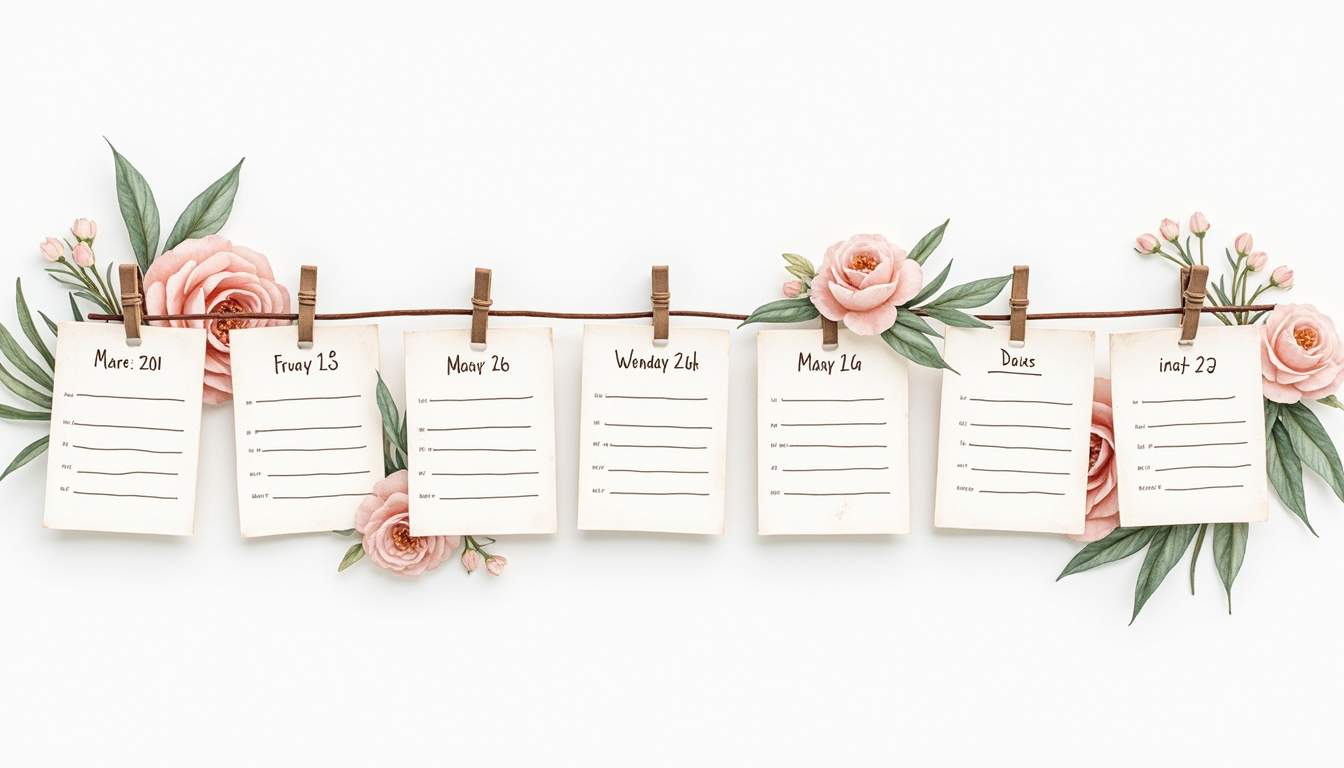
How to Track RSVP Responses for Wedding?
Planning a wedding involves countless details, but few are as crucial as tracking your guest responses. Knowing exactly who's coming helps you finalize seating arrangements, inform your caterer of meal counts, and ensure your special day runs smoothly. Whether you're expecting 50 guests or 500, having an organized system to track RSVPs can save you countless headaches as your wedding day approaches.
Why Tracking RSVPs Matters
Before diving into the "how," let's address the "why." Accurate guest counts affect nearly every aspect of your wedding planning, from venue capacity to catering costs. Without proper tracking, you might end up paying for meals that go uneaten or, worse, not having enough food for everyone who attends.

Beyond the practical aspects, proper RSVP tracking also helps with seating arrangements and personalization. Knowing exactly who's attending allows you to create thoughtful table assignments that consider relationships and personalities. It also enables you to prepare personalized elements like place cards, welcome bags, or favor tags with confidence, avoiding awkward situations where a guest arrives to find no seat card or a missing welcome gift because their attendance wasn't properly recorded.
Many couples also find that RSVP tracking provides valuable peace of mind during an already stressful planning period. Rather than relying on memory or scattered notes about who's coming, a systematic approach transforms this potential source of anxiety into a manageable task. This organization can be particularly helpful when communicating with vendors who frequently request updated guest counts in the weeks leading up to your celebration.
The Financial Impact
Most wedding vendors charge on a per-person basis. With the average cost per guest ranging from $100 to $350 depending on location, each RSVP directly impacts your budget. Accurate tracking helps prevent unnecessary expenses and allows you to allocate funds more effectively across other aspects of your wedding.
Traditional RSVP Tracking Methods
While digital options have gained popularity, many couples still appreciate the elegance and tradition of paper RSVPs. These classic methods have stood the test of time for good reason.
Paper RSVP Cards
The traditional method involves sending RSVP cards with your invitations, complete with pre-addressed, stamped envelopes for guests to return. As these cards arrive, you'll need a system to record the responses. Many couples use a simple spreadsheet with columns for guest names, attendance status, meal choices, and any plus-ones.
To make this method more effective, consider numbering your RSVP cards discreetly on the back. This way, if a guest forgets to write their name (which happens more often than you might expect), you can still identify who the response is from based on your master list that matches numbers to guests.
Handwritten Tracking Systems
Some couples prefer a tangible tracking method like a dedicated wedding planning notebook or binder. You might create sections for "Attending," "Not Attending," and "Pending" responses, moving guests between categories as replies come in. Color-coding can add another layer of organization, especially when tracking meal choices or accommodation needs.
While this method works well for smaller weddings, it can become unwieldy with larger guest lists. Consider combining it with a digital backup to ensure nothing falls through the cracks.
Phone Calls and Verbal Confirmations
For very intimate weddings or when following up with non-responsive guests, phone calls provide a personal touch. Keep a dedicated note in your phone or a section in your planning binder to immediately record these verbal confirmations. Remember that verbal RSVPs should be documented just as carefully as written ones to avoid confusion later.
Digital RSVP Tracking Solutions
Technology has revolutionized wedding planning, offering streamlined solutions for RSVP management that can save time and reduce stress.
Wedding Websites with RSVP Features
Platforms like The Knot, Zola, and WeddingWire offer free wedding websites with built-in RSVP functionality. Guests can respond online using a code provided in your invitation, and the system automatically compiles responses in one place. These platforms typically allow you to export guest data to spreadsheets and often include meal tracking and plus-one management.
The main advantage here is automation—you'll receive instant notifications when guests respond, and the system handles the organization for you. Many couples include the website information on their save-the-dates and formal invitations, giving guests multiple opportunities to find the RSVP page.
RSVP Assistant Service
Hire RSVP Assistant service Lindy (easy and quick rsvp method) to take the stress out of tracking responses. This professional service manages all aspects of your guest list, from sending invitations to compiling responses, making it effortless to keep track of who's attending your wedding. With dedicated support and automated tracking, you can focus on other important aspects of your special day.
Dedicated RSVP Apps
Apps like RSVPify, Paperless Post, and Joy offer specialized RSVP tracking with additional features beyond what wedding websites might provide. These often include customizable questions (dietary restrictions, song requests), automated reminder emails for guests who haven't responded, and detailed analytics about your response rate.
Many of these apps offer free basic versions with premium upgrades available for additional features. The investment can be worthwhile for larger weddings where managing responses manually would be time-consuming.
Spreadsheet Systems
Google Sheets and Microsoft Excel remain popular choices for RSVP tracking due to their flexibility and accessibility. You can create custom columns for all the information you need to track: attendance status, meal choices, plus-ones, gifts received, thank you notes sent, and more.
The collaborative nature of cloud-based spreadsheets allows both partners (and even helpful family members) to update information from anywhere. Consider using conditional formatting to color-code responses visually—perhaps green for confirmed attendees, red for declines, and yellow for pending responses.
Creating an Effective RSVP Tracking System
Regardless of which method you choose, certain principles will help ensure your tracking system serves you well throughout the planning process.
Essential Information to Track
At minimum, your tracking system should include: full names of invited guests, contact information, RSVP status, number of guests attending (if you've offered plus-ones), meal selections (if applicable), and any special accommodations needed. Depending on your wedding, you might also track hotel block reservations, transportation needs, or attendance at additional events like rehearsal dinners or post-wedding brunches.
Consider adding a notes column for any unusual circumstances or special considerations for specific guests. This might include seating preferences, relationships to be aware of when creating seating charts, or other details that will help with planning.
Setting Up Your Master Guest List
Before sending invitations, create a comprehensive master list of all potential guests. Organize this list by household rather than individual to match how you'll address invitations. Include full names, addresses, email addresses, phone numbers, and relationship to you or your partner.
This master list becomes the foundation of your RSVP tracking system. As responses come in, you'll update the status rather than creating a new list from scratch. Consider assigning each household a unique identifier that can be used across all your planning documents for easy reference.
Managing the RSVP Timeline
Timing plays a crucial role in successful RSVP management. A thoughtful timeline helps ensure you receive responses when you need them without overwhelming your guests.

Typically, RSVP deadlines should be set 2-3 weeks before your wedding date. This gives you enough time to finalize numbers with vendors while not asking guests to commit too far in advance. For destination weddings, consider an earlier deadline of 4-6 weeks to accommodate travel planning.
When setting your deadline, also consider when you'll need to provide final counts to your venue and caterer. Add at least a week buffer between your RSVP deadline and when you need to submit these numbers to allow time for following up with non-responders.
Following Up with Non-Responders
Even with the most user-friendly RSVP system, some guests will inevitably miss your deadline. Have a plan for following up, typically starting 3-5 days after the RSVP date has passed. A gentle text message or phone call is usually more effective than an email, which might be overlooked.
When following up, be direct but gracious: "Hi Sarah, we're finalizing our wedding details this week and noticed we haven't received your RSVP yet. We'd love to have you there if you can make it! Could you let us know by Wednesday?" This gives a clear deadline while expressing that their presence is important to you.
Special Considerations for Modern Weddings
Today's weddings often include elements that require additional tracking beyond simple yes/no responses.
Tracking Plus-Ones and Children
Be explicit on your invitations about who exactly is invited. If offering plus-ones, your tracking system should include columns for the guest's partner's name and meal choice. For families, list each child individually rather than just tracking a total number to ensure accurate meal counts and appropriate accommodations.
Some couples create separate tabs or sections for tracking children specifically, especially if providing special meals, activity packs, or childcare services during the reception.
Managing Multi-Event RSVPs
For weddings with multiple events—welcome dinners, rehearsal dinners, post-wedding brunches—consider creating a comprehensive tracking system that includes attendance for each event. This might be separate tabs in a spreadsheet or distinct sections on your wedding website's RSVP form.
Clear communication is key here. Make sure guests understand which events they're invited to and how to RSVP for each one separately. Your tracking system should make it easy to generate attendance lists for each individual event.
Final Thoughts
Whatever RSVP tracking method you choose, the key is consistency. Update your system as soon as responses arrive, and schedule regular check-ins with your partner to review the status of your guest list. Remember that your tracking system serves as the foundation for many other aspects of wedding planning, from seating charts to welcome bags.
